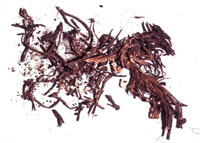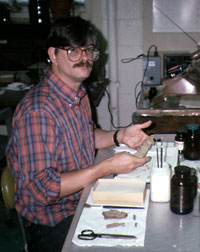Understanding What You Have
Once materials are stabilized, investigative cleaning will help retain the information objects have to offer. This task occurs in the laboratory where special apparatus are available. Decorative elements such as over-glazed painting on porcelain, tool markings on metals and waterlogged materials, and specialized coatings and plating on metals all have a story to tell. Materials are further prioritized and sorted for conservation during this initial cleaning phase and documentation of materials, both written and photographic, begins. Stabilization of materials may include testing porous materials for chlorides and desalinating artifacts that contain high salt levels. Corroded metals will be dried and stored in a dry environment until conservation treatments can begin.

Preserved rosemary sprigs from coffin. Rosemary is known as the
herb of remembrance.
The team at the William and Mary Archaeological Conservation Center worked on the lead coffins and found that they had similar corrosion patterns. The surfaces were covered in lead carbonate and lead oxide corrosion. The team agreed that the corrosion would not be removed, as it was protective, well-adhered and the pattern preserved in it offered information about how the coffins were made. Silt and minerals were removed and the lead was then coated in a stable acrylic resin.
The Canadian Conservation Institute (CCI) handled most of the organic materials. Wet textiles, rosemary sprigs, and damp rope fragments were cleaned using soft brushes and filtered water. Conservators used a stereomicroscope and tweezers to remove tiny debris, such as insect casings and plant rootlets. Objects were impregnated with a stable preservative then freeze-dried. Dry organic artifacts were too fragile to be cleaned with water so debris was removed using a stereomicroscope and tweezers. The condition of the inner wood coffins ranged from sound to highly saturated and deteriorated. The wood was mapped and numbered in the field and then initially treated by conservators from the Maryland Historical Trust from and Museum. Later, the planks were freeze-dried by Clifford Cook at Parks Canada with the assistance of CCI and Katherine Singley, a conservator in private practice.

Conservator Curtis Moyer treating a fragment of lead from the smallest coffin. Treatment plans are designed to optimize the protection of the object and the recovery of information.
As part of the ongoing research into the wealth of materials recovered from inside the lead coffins, HSMC has undertaken more specialized analyses.
Fiber Fossil Analysis
Corrosion products on copper alloy shroud pins actually preserve “fossils” of the textile they once secured. Examination of these fossils either by electron microscope and extremely high magnification light microscope allow for the identification of specific fiber remains by comparison with modern examples.
One of the unique discoveries of the lead coffin project was, that even though much of Philip Calvert’s skeleton was very poorly preserved, his hair emerged from the coffin in extremely good condition. Read about the ongoing study of this rare discovery.
Corrosion products on copper alloy shroud pins actually preserve “fossils” of the textile they once secured. Examination of these fossils either by electron microscope and extremely high magnification light microscope allow for the identification of specific fiber remains by comparison with modern examples


